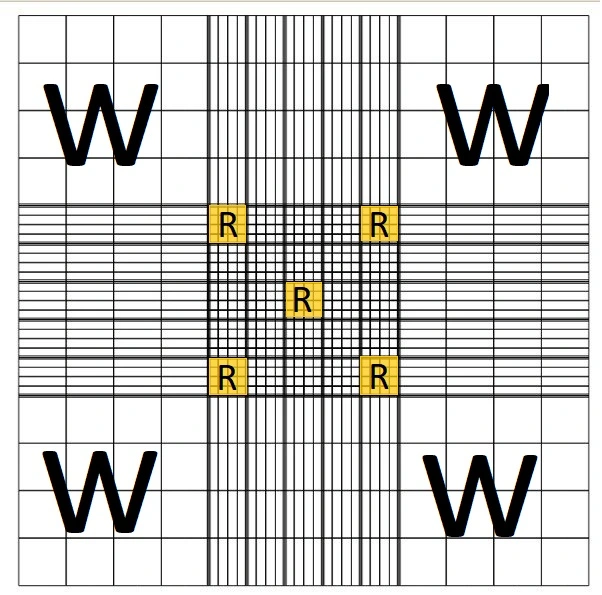Introduction
Performing an accurate red blood cell (RBC) count is an essential part of many medical and laboratory procedures. One commonly used method is Neubauer’s specialized counting chamber which allows for precise measurements. In this step-by-step guide, we will walk you through performing an accurate RBC count using Neubauer’s chamber.
Aim:
To perform RBC count by using Neubauer’s chamber.
Principle:
For RBC Count the blood specimen is diluted 1:200 with the R.B.C. diluting fluid & cells are counted under high power by using a counting chamber. The number of cells in undiluted blood is calculated & reported as the number of RBC/cumm of whole blood.
RBC Count Requirements:
1. Microscope
2. Improved Neubauer’s chamber
3. RBC pipette
4. RBC diluting fluid
5. Specimens-
Double oxalate or EDTA blood
Mix the anticoagulated blood carefully.
Draw blood up to 0.5 marks.
Draw diluting fluid up to 101 marks.
The pipette is rotated rapidly by keeping it horizontal during mixing.
After 5 minutes, by discarding a few drops from the pipette & holding it slightly inclined small volume of the fluid is introduced under a cover slip on the counting chamber.
Allow the cells to settle for 2 to 3 minutes.
Place the counting chamber on the stage of the microscope.
Adjust it under low power objective & locate
the large square in the center with 25 small squares.
Now switch to high power objective.
In the central square out of 25 squares count RBCs in 4 corner squares & One Central Square.
Calculation –
Total RBC count /cumm = Number of red cells counted x dilution factor/
Area counted x depth of the chamber
Where—
Dilution =1:200
Area counted= 80 /400 =1/5 sq. mm.
Depth of chamber =1/10 mm or 0.1mm
Number of red cells counted=N
Hence total RBC Count /cumm = N×200
1/5 × 1/10
= N×200×50
= N× 10,000
Normal value:
Male- 4.5 to 6.0 x106cells/cumm
Female- 4.0 to 4.5 x 106cells/cumm
Clinical significance:
Hemoconcentration due to burns, and cholera.
Central cyanotic stages are seen in chronic heart disease.
Decrease lung function.
Polycythemia. A decrease in RBC count is observed in conditions such as –
Old age
In pregnancy
Different anemias
Note:
RBC count using Neubauer’s chamber is a widely used method for determining red blood cell concentration in a given sample. However, it comes with several limitations and disadvantages:
Also Read:
- Bile Salt (Hay’s Sulphur Method)
- Estimation of occult blood in stool by Benzidine method.
“Unlocking the Secrets of Urine: A Comprehensive Guide to Urine Examination”
- Glucosuria (Benedict Method)
- Ketone Body (Rotheras, Gerhardt’s and Strip Method)
- Proteinuria (Heat and acetic acid, Sulphur Salicylic Acid, Hellers or Nitric acid, and Esbach albuminometer Method)
- Bence Jones Proteinuria (HCl Method)
- Urobilinogen (Ehrlich Method)
- Bile Pigment (Fouchets Method)
- Occult Blood (Orthotoluidine and Benzidine Method).
- Sedimentation Preparation
- Slide Preparation
- Microscopic Examination.
Reference
“Hoffbrand’s Essential Haematology” by A. Victor Hoffbrand, Paul A.H. Moss, and John E. Pettit: This is a comprehensive and highly regarded textbook that covers the fundamental principles of hematology.
“Williams Hematology” by Kenneth Kaushansky, Marshall A. Lichtman, Josef T. Prchal, Marcel M. Levi, Oliver W. Press, and Linda J. Burns: This is a renowned textbook that provides in-depth coverage of both clinical and basic aspects of hematology.
“Wintrobe’s Clinical Hematology” by John P. Greer, Daniel A. Arber, Bertil E. Glader, Alan F. List, Robert T. Means Jr., Frixos Paraskevas, George M. Rodgers, and Michael H. Schmitt: This classic text has been a staple in the field of hematology for many years and offers comprehensive information on various hematological disorders.
“Hematology: Basic Principles and Practice” by Ronald Hoffman, Edward J. Benz Jr., Leslie E. Silberstein, Helen Heslop, John Anastasi, and Jeffrey Weitz: This textbook provides a detailed overview of the principles and practice of hematology, including the latest advancements in the field.
“Clinical Hematology and Fundamentals of Hemostasis” by Denise M. Harmening: This book is a good choice for those looking for a comprehensive guide to both clinical hematology and hemostasis.
“Rodak’s Hematology: Clinical Principles and Applications” by Elaine M. Keohane, Larry Smith, and Jeanine M. Walenga: This text focuses on the clinical application of hematology concepts and includes practical information for laboratory professionals.
“Hematology in Clinical Practice” by Robert S. Hillman, Kenneth A. Ault, and Henry M. Rinder: This book is designed for healthcare professionals and provides a practical approach to hematology in a clinical setting.
“Consultative Hematology: An Issue of Hematology/Oncology Clinics of North America” edited by Mikkael A. Sekeres and Christopher R. Cogle: This book focuses on the consultative aspects of hematology and is a valuable resource for clinicians.

